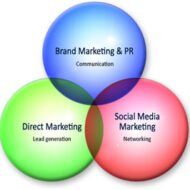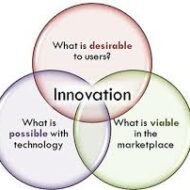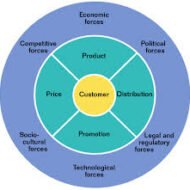Posted by Managementguru in Entrepreneurship, Project Management
on Mar 6th, 2014 | 0 comments

How can we define Business? Business is an important institution in the society. Be it for the supply of goods and services; Creation of employment opportunities; Offering better quality of life; Contribution to the economic growth of a country; the role of business is crucial. The subject of business is as interesting as its role in society. The more one reads about it, more interesting does business become. To be successful, you have to have your heart in your business, and your business in your heart. – Thomas Watson Sr. Entrepreneurial activities The increasing number of business schools and institutions signify the importance and the need for training the students on rudiments of business management. Developing countries encourage entrepreneurial activities and view it as a strategy to improve the GDP (Gross Domestic Product). More business activity means increased per capita income and increased standard of living. A business must make profit to succeed. Profit is income minus outgo. It is the main incentive for starting a business. Business people weigh each of their decisions in terms of making profit and avoiding loss. In a corporate environment, business has to aim for wealth maximization apart from profit maximization to increase the shareholder’s wealth in the long run. The scope of business is indeed vast. It all depends on how well you have analyzed and understood the nuances of your business activity, in order to survive and sustain in the market. Supply Chain The supply chain in a business activity involves numerous links in the form of manufacturers, supplier of raw materials to the manufacturer, dealers, logistics, intermediaries, consumers, bankers, advertising agencies, insurance agencies and so on. All these elements have to function in a coordinated manner for the benefit of the consumer. Now days, business has become customer-centric rather than product-centric. This serves both the purpose of product development in lieu of customer needs and customer satisfaction. The multitudinous activities involved in bringing raw materials to the factory and the end product from there to the market constitute business. In addition, a business activity has to comply with legal restrictions and government regulations. A business is also expected to discharge its social obligations to consumers, employees, owners and to other interest groups, which have stakes in business directly or indirectly. Planning and organization Planning and organization are two key principles in running a business enterprise as planning sets up a concrete premise on which action plans can be developed and organized activities assures definite success. Modern business is dynamic. Future business will be knowledge based and brainpower will be in greater demand. Organizations have become flat. Eight to twelve organizational layers have been reduced to two or three. Gone are the days of sheltered markets, subsidies, licenses, quotas and restrictions. Businesspersons are asked to stand on their feet, to eliminate inefficiencies, cut down costs and improve productivity. LoL! It might be said that it is the ideal of the employer to have production without employees and the ideal of the employee is to have income without work. –E. F....

Posted by Managementguru in Business Management, Marketing, Principles of Management
on Mar 4th, 2014 | 0 comments

Integrated Marketing: Strategy aimed at combining different marketing methods such as mass marketing, one-to-one marketing, and direct marketing. Marketing in simpler terms means “to take your product to the customers in a convincing manner and coax them to buy it”. And not only that, you need to retain your old customers and lure new customers to your niche. How is that possible! Marketing is a concept that works magic when you project your product in such a way as to attract the customer and also your product should have an edge over that of your competitors’. Many new channels of marketing have flooded the market; the evergreen being advertisements in radio and televisions. The audio visual of your product that is being telecast in a span of thirty seconds to one minute should capture the attention of the viewers and you should see to it that the benefits of your product is communicated to the viewers in a precise manner. The questions that are inevitable to the sales force are, What is your product’s unique selling proposition? What is your distinctive competence? Are you motivating the target audience? Does your product have a brand image? So many things have to be taken into consideration and here comes the word integrated marketing. The exclusive sales force you own is your strength, without which you cannot succeed in the market. Whatever strategies you formulate, action plans you correlate, it is in the hands of your sales team that you are going to capture the market. The marketing plan and ideas have to be communicated to them from the point of conception and the innovative ideas generated from your team can be definitely put into use. Integrated marketing operates on two levels. First the various disciplines of the marketing department that includes, sales force advertising product management new product launch Marketing research, must work in tandem. Secondly, coordination with all the other departments in the firm. After all, business is done for profit. But even then there are some etiquettes to be followed when you are planning to introduce your product into the market. customer satisfaction quality quantity eco friendly Competitive price, are some of the basic principles that go without saying. Besides, the producer also should not deceive the customer or take advantage of the ignorance of the consumer while campaigning for his products. A product should reap you profit and at the same time the customer should get the value for the money paid. A satisfied customer can bring in hundred more customers; it is part of your marketing plan. If you lose one customer then you have lost thousand customers. You cannot bring back a dissatisfied customer into your groove. So the sociology and psychology which you have read only in literature will give you a helping hand in times of need, when you want to satisfy a customer. Integrated marketing combines all the marketing plans; it is a marketing mix that makes a customer happy with the product’s price, availability, promotion and the product as a whole. Hotels and restaurants Hospitals Malls and Departmental stores, are some of the ventures to be mentioned that stands as a testimony for integrated marketing, as they talk about “feasible packages for different classes of economy”. Ultimately marketing can be defined as a network that starts with the customer and ends with the customer in its supply chain...

Posted by Managementguru in Business Management, Marketing, Principles of Management
on Mar 4th, 2014 | 0 comments

The Realm of Product Innovation A manufacturer or a service provider, who aspires to be successful in a business market, must indulge himself in research, pertaining to consumer preference as well as the various stages of a product life cycle. This will give him a better chance to make his future decisions concerning the product and also the wisdom to evolve strategies accordingly. Developing a product and introducing it into the market demands certain amount of forethought and prudence. The first step is to study the market, to understand consumer preference as well as to gauge whether your product will be appealing to the customers existing in that market. The prerequisite for this would be market segmentation, that is to statistically estimate the demographic quotient (people belonging to different age groups and ethnic societies) of the sample population and decide on the customers whom you want to target. A product’s success depends mainly on two things: 1) Innovation-lateral thinking, by which you let loose of all your unorthodox methods and stick onto some novel ideas of marketing. 2) Customer-oriented marketing rather than product oriented. This customer oriented concept is advocated by modern marketing consultants and it has proven to be a fantastic proposition. More than the actual product, people like to know more about the values that they obtain out of that product. The secret behind success will be to hit the right note, by propagating more about the value added services that go with the product. Expectations Created by the Product When a product is introduced in a market, say, automobiles for example, since every tom, dick and harry is fond of cars and bikes and they talk a lot about it. It is looked upon by prospective customers with great expectations, which might be due to the great hype created by the manufacturer through advertisements in electronic media, papers and magazines. The product as it hits the market will instantaneously make it big, if it has the right mix of intangible and augmented benefits that make customers happy and they feel that they have bought something worth the money paid for. A luxury car is well received by the market, irrespective of the price tag that is stuck to it, just because of the value added benefits such as, delicacy, great speed, high-performance, safety, insurance and warranty. Product Pre-Launch Analysis Before launching a product, industry analysis is a must, as various similar products might exist and it comes to the question of how different and appealing your product is, for market acceptance. Even minor things can make a big difference, say, for instance, if you are able to float the cheapest car, in terms of price but with great fuel efficiency, the results are obvious. The strategy would be to introduce innovations not only in your product but also in your thinking. Best products emerge as a result of tuning in your wavelength with that of the consumers’. Product Life Cycle A product gets introduced, grows, matures, stabilises and slowly withers off, just like a human being. No man is eternal and so is a product. You may argue that some products are in the limelight for more than their share of lifetime. If you keenly observe, that would have been the result of makeover changes to the product in lieu of the change in people’s liking and analysis of market trend. Some products have a second chance to prove their mettle. They go into hibernation for a while and then re-enter when market conditions seems to be favorable. The perspective from which you look at the life cycle of a product may cast a different idea...

Posted by Managementguru in Business Management, Marketing, Principles of Management
on Mar 4th, 2014 | 0 comments

Key Components of Marketing System The core marketing system of a company comprises the suppliers, company, marketing intermediaries and target customers. The success of the company is also affected by competitor’s presence and other segments of public. The management has to watch and plan for all these factors to serve and satisfy the specified set of needs of a chosen target market. Supplier Selection: A company has to choose suppliers who offer the best mix of quality, delivery schedule, guarantee and low cost. Say, a firm involved in manufacturing confectioneries has to procure sugar, cocoa, caramel, milk powder; Labor, equipment, fuel, electricity and other factors of production are also to be obtained. If the company’s product has a good market, it can opt for continuous production. If it is a growing firm, it cannot go for voluminous production, but only supply goods against confirmed orders. In either case, the choice of suppliers is determined by one major factor called ‘cost’. Of course, one can never compromise on quality and so the company has to decide whether to purchase the inputs or make its own. Pic Courtesy : 5 Steps to Successful Supplier Selection The relationship of a company with the suppliers should be of a long-term nature, since any sudden change in the supplier’s environment will have a substantial impact on the company’s marketing operations. Sudden supply shortages, labor strikes and other events can interfere with the fulfillment of delivery promises to customers. This will result in sales decline in the short run and loss of goodwill in the long run. Back orders lead to loss of customers and in course of time their trust. The business firms must plan for alternate source of supply to avoid the risk of over-dependence on any one source of supplier. Company The marketing department has to work in tandem with the other departments of the company namely, finance, production, personnel and research and development, while designing and implementing its marketing plans. Finance department – has to be consulted regarding the availability and deployment of funds to carry out the marketing plans. Production department – to gauge market demand and to decide on the supply of products based on demand. R and D – new product development. Equally important is Digital Marketing which is considered to be an integral part of your promotional activities – What you are seeing above is a depiction of tools that help you in marketing your products online. Marketing intermediaries: Channel members are the link between the company and the customers. Agents and middlemen find customers who are wholesalers or retailers to take on the title and sell the merchandise. Also there are physical distribution firms who assist in stocking and moving goods from the warehouse to the destinations. The marketing executives have to deal with these intermediaries prudently in order to enhance the operational efficiency of the marketing function. Logistic firms, shippers and airliners help to move the goods from one location to another. Competitors: All the business firms in a particular market segment vie for the same resources and customers. A car manufacturing company in an automobile industry has to compete with other car manufacturers as well as with two wheelers. This implies that competition may come in different forms and each company has to identify potential threat from competitors, study their activities and capture their moves to win over the competition. Public: A company has to keep a close watch on people’s preferences to satisfy their requirements and also it is expected to give back something to the society in the form of social welfare measures. Employees belonging to different culture groups with differing attitudes,...

Posted by Managementguru in Business Management, Marketing, Principles of Management
on Mar 4th, 2014 | 0 comments

Market Research for Product Line Management Business firms, whether involved in the manufacture of goods or delivery of services, have to understand the importance of marketing research that would give a fair idea about their territory of operations and the scope for development. Let me first clarify the obvious difference between a market research and marketing research. While market research is confined to only a market which comprises of its potential and actual buyers, a marketing research delves deep into and further beyond, covering all areas of marketing including the market. Identification of Consumer Needs: Identification of consumer needs and satisfying them is vital for the emergence of a buyers market. Although firms manufacture goods that are competitive in terms of quality and price, it is the middlemen, the linking factor between the manufacturer and the wholesaler or retailer, that have a commanding grip on distribution, affecting sales volumes. Extensive marketing research will help firms to solve such problems of middlemen and distribution, to cater to the needs of the ever expanding market. Preference of People: People’s preference always changes resulting in a sea change of market conditions. In order to anticipate and meet any such changes, a firm needs to analyze the market conditions on a day to day basis. Also improving the product design helps a firm to retain its customer base. How does a firm survive in the market without knowing the elemental changes that are happening in its immediate environment? Pricing is one of the crucial factors that determine the acceptance ratio of a product or range of products. Information Source: Marketingtutor A separate department is maintained by some top corporate firms to collect relevant information about the pricing strategies of rival companies that helps them to take the market lead, by quoting competitive prices comparatively. Such secret agendas are a need of the hour to outsmart your rivals. Sales Promotion and Advertisement Campaigns: Another component of the research planning is sales promotion and advertisement campaigns. Sales promotion is solely dependent upon the sales force and the marketing manager has to play a key role in integrating their functions to bring out their strengths. The activities of the sales personnel should be oriented towards targets and a mission without a target is like travelling without knowing the destination. Information Source: BBAMANTRA When we talk about advertisements, they not only sell tangible products but also intangible things like morals, values, love etc., So, it becomes even more important for the advertisers to follow some built in standards that does not affect the ethical values of the society concerned and also they should make it a point not to make women a mere object of attraction. The market research that is a part of marketing research includes the study of the following: Market sizeMarket potentialMarket shareMarket segmentsMarket trends and seasonal trendsSales forecastingConsumer profileConsumer preferenceCompetitor analysisMeasuring the price elasticity of demand and much more. Such marketing research helps a firm to develop a comprehensive plan regarding effective training programmes, sales force management, research and development programmers and effective control mechanisms. It also facilitates efficient decision making and the operational tasks of marketing management, thereby contributing to customer satisfaction and efficiency of the...










